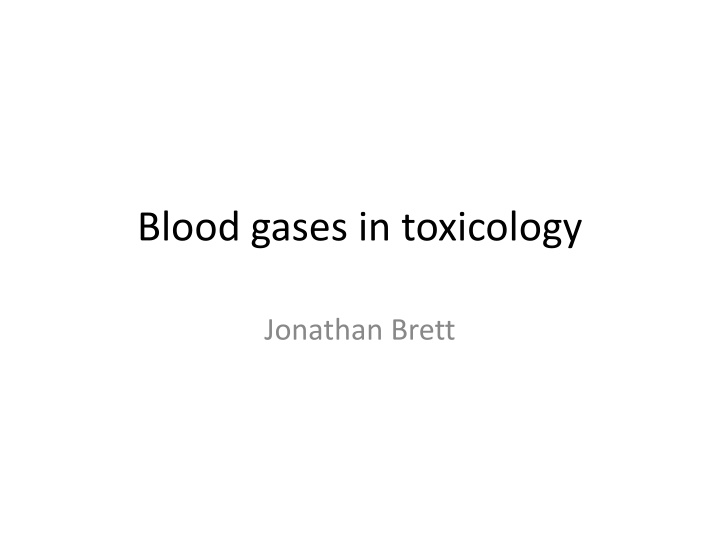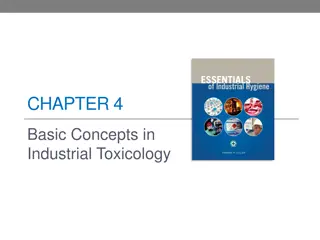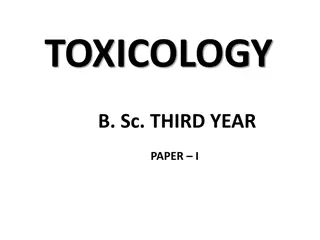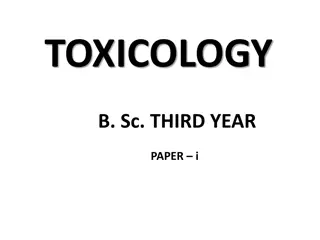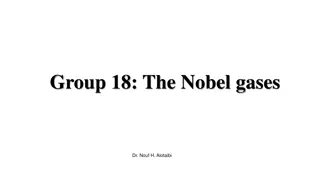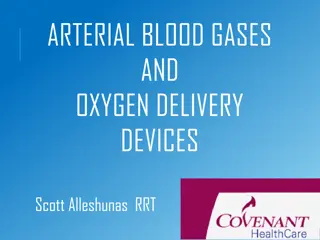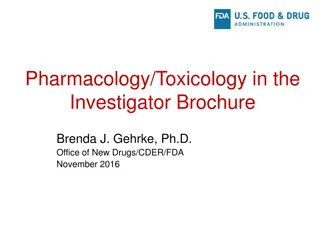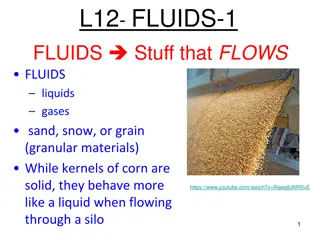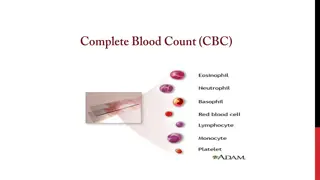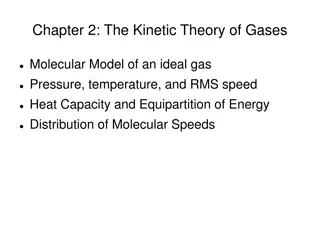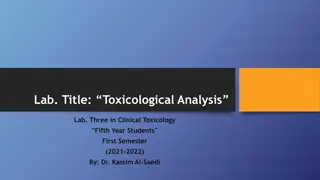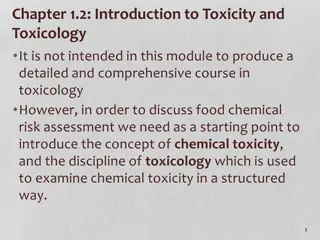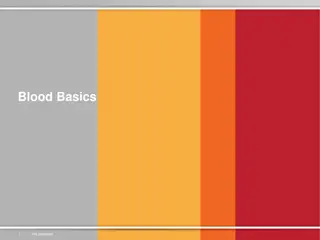Blood Gases in Toxicology - An Overview
The significance of blood gases in toxicology, focusing on anion gap, metabolic acidosis, and osmolar gap. Case studies and images illustrate common toxicological scenarios and diagnostic challenges. Learn about the interpretation of key parameters like anion gap, lactate levels, and osmolarity to identify toxic exposures and metabolic imbalances.
Download Presentation

Please find below an Image/Link to download the presentation.
The content on the website is provided AS IS for your information and personal use only. It may not be sold, licensed, or shared on other websites without obtaining consent from the author.If you encounter any issues during the download, it is possible that the publisher has removed the file from their server.
You are allowed to download the files provided on this website for personal or commercial use, subject to the condition that they are used lawfully. All files are the property of their respective owners.
The content on the website is provided AS IS for your information and personal use only. It may not be sold, licensed, or shared on other websites without obtaining consent from the author.
E N D
Presentation Transcript
Blood gases in toxicology Jonathan Brett
Anion Gap Delta Gap Osmolar Gap Lactate Gap History Gap Knowledge Gap
Anion Gap Anion gap = Na+ -(Cl-+ HCO3-)
High Anion Gap Metabolic Acidosis Carbon monoxide, Cyanide AKA, Alcohol Toluene Methanol, Metformin Uraemia DKA PGA/Paracetamol/Propylene glycol/Propofol INH, Iron Lactic acidosis Ethylene glycol Salicylates, Strychnine
High Anion Gap Metabolic Acidosis Lactate Ketones Renal Failure Toxins
Case 1 43M Microbiology Scientist Excessive alcohol use Found unconscious (GCS 6) on floor Vomiting Empty bottle of clear liquid next to him with no labels
Case 1 pH 7.26 pCO2 49 HCO3 21 Lactate 3.6 BE -5.6 Ethanol 64 mmol/L Metabolic Acidosis & Respiratory Acidosis (mild)
Case 1 Calculated Osmolarity285 Measured Osmolality 365 = OG 80
Osmolar Gap Methanol Ethylene Glycol Dyes (contrast) Isopropyl alcohol Ethanol O(other)
Calculated osmolarity Calculated Osmolarity = 2Na + gluc+ urea + 1.25(ethanol) Units must be mmol/L mg/dl ( 4.6) % ( 218)
Case 1 Calculated Osmolarity285 Measured Osmolality 365 = OG 80 Ethanol 64 (x 1.25) = 80 OG = 0
Case 2 08:30 well 12:30 -drowsy and confused GCS 12 HR112 BP 159/103 pH 7.19 CO226 BE -16 BSL 9 Lactate 35 Cr 61 Other bloods pending
Case 2 Progress: Paracetamol undetected Ethanol undetected Osmolar gap 40 Intubated Ethanol Infusion and Dialysis commenced (CVVHDF) Next day: pH 7.35 BE -10, Lactate 5.2 Methanol and ethylene glycol concentrations negative
Propylene glycol Environmentally safe antifreeze Diluent for pharmaceuticals Extremely high lactate concentrations as a metabolite (d-lactate)
Case 3 26M Methamphetamine user Drug-induced psychosis Personality disorder Went to police claiming he was stabbed Agitated with auditory hallucinations Brought to ED 1h ago. Claiming he had home brew -no other details.
Case 3 Agitated Sweaty Psychotic HR 140 Normotensive RR 30 Afebrile
Case 3 pH 6.9 CO2 28 HCO3 6 Na 135 Cl 105 lactate 26 BE -24 Na 139 Cl 96 Ur 4.3 Cr 199 glucose 21.5 Ethanol undetected Serum osmolality 319
Case 3 What kind of acidosis is this? A. HAGMA B. NAGMA C. Resp. acidosis D. I m not willing to commit at this stage
Case 3 Anion gap =Anion gap = Na+ -(Cl-+ HCO3-) = 135 (105+6) = 24 HAGMA (lactic acidosis)
Case 3 Delta Ratio = the increase in Anion Gap / the decrease in HCO3- = [actual anion gap normal AG]/ normal actual bicarb] = (24-12)/(24 6) = 0.66 NAGMA (renal failure) < 0.4: Hyperchloraemic NAGMA 0.4-0.8: Mixed NAGMA + HAGMA 1-2: HAGMA >2: HAGMA on background of chronic metabolic alkalosis (e.g. COPD with type 2 resp failure)
Case 3 Expected PaC02 (Winters formula) = (HCO3 x 1.5) +8 ( 2) = (6 x 1.5) +8 = 17 (actual 28) (respiratory acidosis)
Case 3 Given IM droperidol with good effect. HR 120 RR 22 GCS 14 and calmer 2.5L IV Fluids
Case 4 52 F Well at 0930 but husband found at 1130 drowsy on floor Initial Obs: HR 134, BP 142/87, Sp02 96% on 10L NRB GCS 13 (E3, V4, M6)
Case 4 RR 30, BP 150/102, HR 106, Sats 100% on 2LNP pH 7.19, CO 26, HCO3 20, Lactate 25, BSL 7.5 Na 145, Cl 111, Ur 3.9, creat 66, BSL 5.1, BAC 10, measured osmo 357 Calculate the gaps AG = 14 (but lactate 25) OG = 46
Lactate gap Increases in lactate usually an indicator of anaerobic metabolism (exep. Propylene glycol) Lactate gap = lactate (measured by oxidase method) laboratory lactate (dehydrogenase method) Caused by EG cross reacting Esp. point of care analysers (e.g. Radiometer 700 >> iSTAT and Bayer)
Case 5 59 female Seen by son at 3pm previous day and drowsy Son thought she may be post-ictal so observed her at home Became concerned when no improvement and called ambulance 8 hours later A- patent B - RR 8, Sa02 100% on 15L NRB chest clear C - Warm, well perfused, HR 120, BP 133/110 HSDNM D - GCS 10 - E 3, V2, M 5 - pupils equal 3mm, sluggish - normal tone and reflexes E - Temp 36.4 - no obvious injuries or abnormalities
Case 5 BKG. Chronic low back pain Hypertension Epilepsy - last seizure 18 months ago Previous gastric surgery for perf. DU in 2012 Denies ETOH or illicit drug misuse Increasing abdominal pain, anorexia and 15Kg since Christmas.
Medications Oxycontin 80mg BD Pantoprazole: 80 mg, Oral, Twice daily Nizatidine: 300 mg, Oral, Nocte. Amlodipine: 10 mg, Oral, Mane Valsartan: 320 mg, Oral, Once daily Paracetamol: 1 Grams, Oral, Four times daily Domperidone 10 mg: Oral, Three times daily Metoprolol: Unchanged, 100 Milligrams, Oral, Twice daily Prazosin: Unchanged, 5 Milligrams, Oral, Twice daily Phenytoin: Unchanged, 200 Milligrams, Oral, Twice daily Gabapentin: Unchanged, 800 Milligrams, Oral, Twice daily
Initial bloods Results pH p02 (mmHg) pc02 (mmHg) Sp02 Bicarb (mmol/L) BE (mmol/L) gluc (mmol/L) Lactate (mmol/L) 9/02/2014 Albumin ALP GGT ALT/AST Trop HS Calc/Mg/Pos Lipase WCC Neut Hb PLT Osmo INR Salicylate TSH UDS 37 154 235 7.07 233 27 99% 10 -18 5.9 0.5 N 17 N 932 26.2 24.1 131 661 297 1.1 Na+ (mmol/L) K+ (mmol/L) Cl- (mmol/L) Bicarb Ur (mmol/L) Cr (mmol/L) 135 2.7 112 10 Neg N Opioids 7 88
Case 5 Anion gap = 135 (10+112) = 13 [NAGMA]
Case 5 NSAID abuse (neurofen plus) [Na]+[K]-[Cl]
NAGMA Bicarbonate loss or chloride retention Drugs Acetazolamide and other CA inhibitors (e.g. topiramate) Cholestyramine GI losses Excess NaCl 0.9% Renal losses RTA Addisons Hyperchloraemia Acetazolamide, Addison s Renal tubular acidosis Diarrhoea, ileostomies, fistulae Ureteroenterostomies Pancreatoenterostomies
Acidosis (pH<7.35) Bic, normal/low C02 C02, normal bic - respiratory AG - HAGMA Delta Ratio ?NAGMA component OG (adjusted for ETOH) ?toxic alcohol ?adequate respiratory compensation
